
Introduction
“Qin Lang, Class 8, Grade 1, XX Primary School, your winter vacation homework was left in the toilet in Paris!” a blogger from China unexpectedly found a Chinese exercise book in a foreign land. How dramatic! How fascinating! Isn’t it? When such a video was uploaded to social media platforms by a blogger with tens of millions of followers, it immediately captured everyone’s attention. What followed were likes, comments, and shares, continuous shares. The news that a primary school student named Qin Lang had lost his exercise book spread explosively. The video quickly reached tens of millions of views, and related topics even repeatedly topped the hot search list on Weibo. People were all asking, who exactly is Qin Lang? Where is he?
The public were obsessed with finding this mysterious primary school student Qin Lang, hoping his exercise book can be returned. More and more people and institutions were involved. When the impact became incalculable, all the truth came to light. It turned out to be a fake news story, and all the information was fabricated by the blogger. This grand and noisy manhunt farce ended with the blogger’s account being banned across all online platforms. (Chinese vlogger banned, 2024)
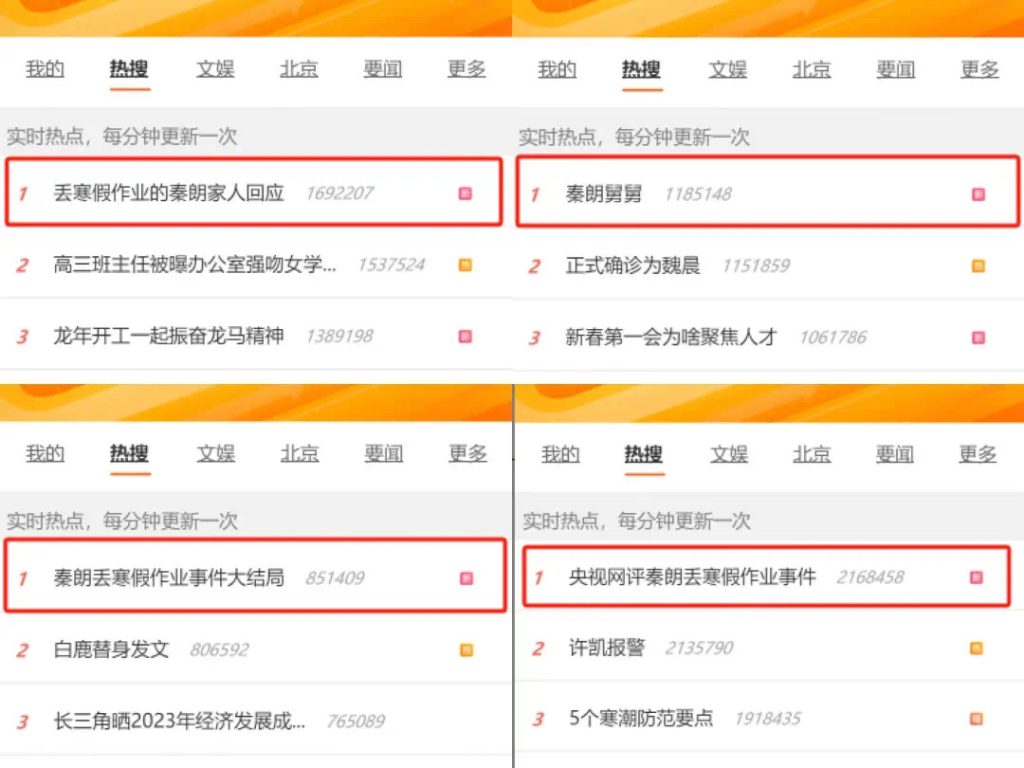
When we calm down, it’s not hard to spot the unnatural aspects of this story. Why could such a well-planned fake news story deceive so many people?
Everyone was manipulated by emotions. This is the post-truth era we are in, where emotions and personal beliefs have a greater impact on public perception than objective facts. (McIntyre, 2018) When rational thinking becomes difficult, this leads to the massive spread of misinformation. The convenience of digital platforms has further facilitated the creation and rapid, wide-scale spread of misinformation and disinformation. (Bianchi& Tafuri, 2023) In the digital information environment, false information not only affects the public opinion ecosystem but also damage social trust. People no longer trust the information provided by the media, and the media’s credibility is gradually eroding. (Das, 2023) It became a political issue, which impacts real people, social trust, and even public policies.

The Birth and Collapse of a “Perfect Lie”
Let’s review the timeline of the entire incident once again.
It took place in 2024.
On February 16th, the blogger “Thurman Maoyibei” with tens of millions of followers released a video on Chinese social platforms such as Douyin, Bilibili, and Weibo. It titled “Your Winter Homework Is Missing, You Must Be Very Worried, Right?” After it was released, it quickly sparked heated discussions among netizens and topped the hot search list. Soon, some netizens who claimed to be Teacher of Qin Lang and his uncle left messages in the comment section. The one who called himself “Uncle of Qin Lang” even started a live stream, which attracted a large number of netizens to watch. (Chasing Clout, 2024)
On February 17th, the netizen Surnamed Yang was administratively punished by the police for spreading rumors about a certain school and staging a live stream of going to a bookstore to buy new homework books for his nephew as the “owner’s” uncle.

On February 19th, “Maoyibei” released a new video, in which she claimed to have found the child’s mother. In the video, she also showed the chat records with “Qin Lang’s mother”. However, as the name of the school was not disclosed, netizens still expressed doubts.

On February 21st, relevant authorities intervened in the investigation of the “lost homework” incident. Official media made their first statement, criticizing the behavior of online bloggers for releasing false information.
On April 12th, the Public Security Bureau of Xihu District, Hangzhou City, issued an announcement. It stated that in order to attract followers and traffic, the netizen “Maoyibei” and her colleague surnamed Xue jointly planned and fabricated the video script series of “Finding the Lost Homework Book of Primary School Student Qin Lang”, which caused a bad influence. “Maoyibei”released an apology video, admitting to fabricating false information.
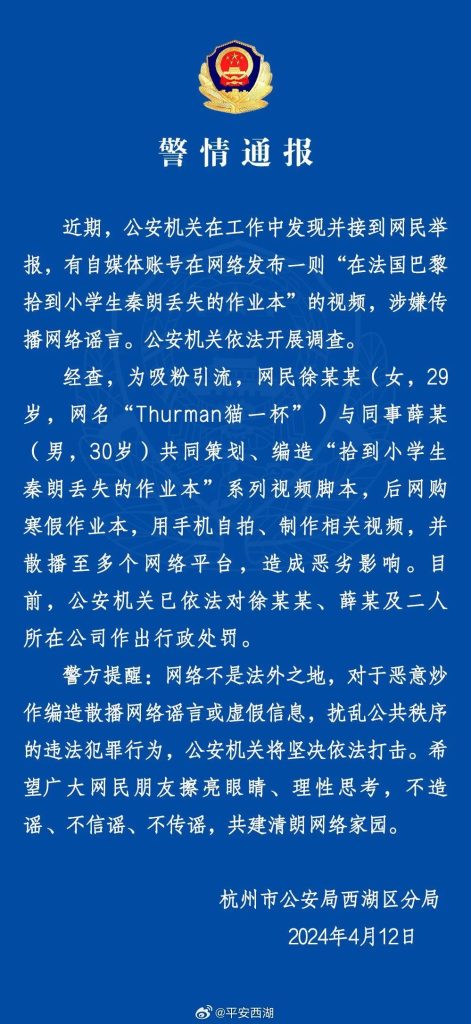
On April 13th, Douyin, Kuaishou, Bilibili and other platforms issued announcements, in which they stated that they would indefinitely ban the account “Maoyibei”, remove related videos. And the reason was “planning false incidents to attract attention, violating community rules”.
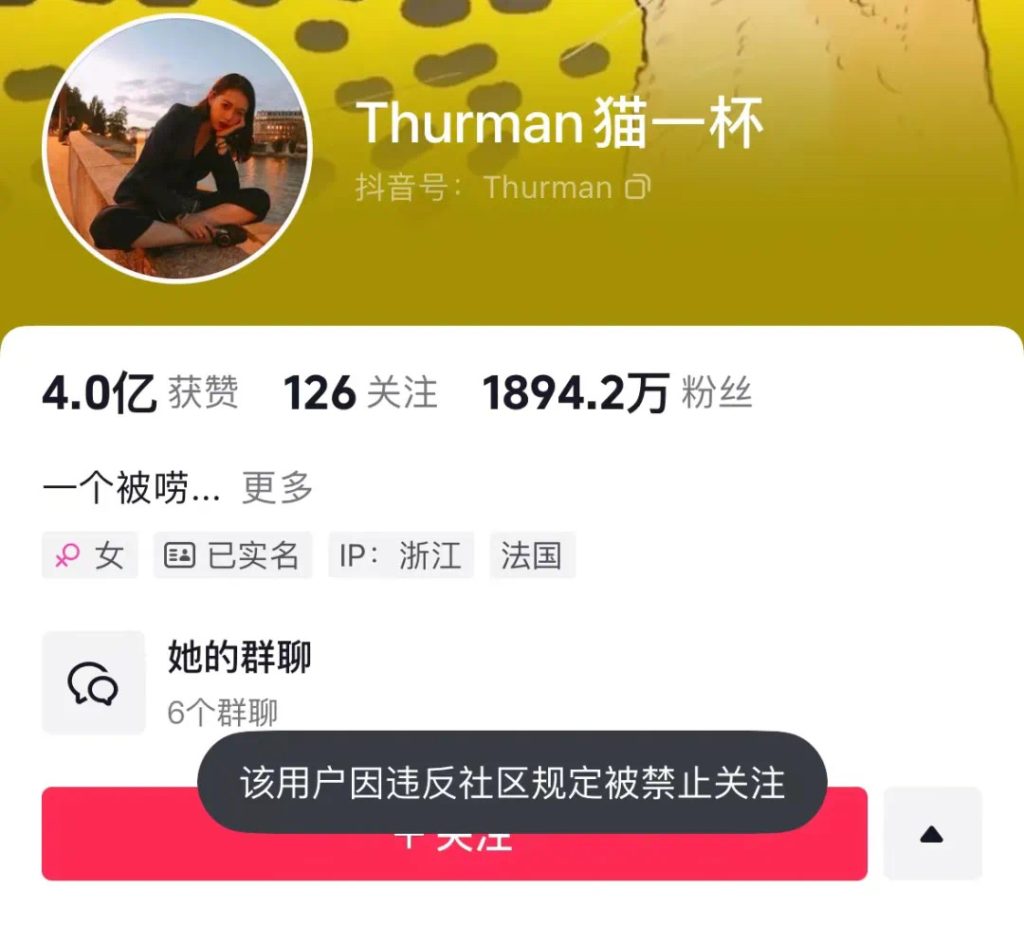
So far, this fake news incident has finally come to an end.
In this incident, the fabrication of disinformation, the blind belief and widespread dissemination by netizens, as well as the intervention and regulation by government departments were all reflected. This makes it a microcosm of today’s digital policy and governance in China.
Why is it more difficult to deal with misinformation and disinformation in the post-truth era?
To face the series of issues brought about by misinformation and disinformation, let’s once again clarify the definitions of these two concepts. According to Data & Society Report (2017), misinformation is “information whose inaccuracy is unintentional”, while disinformation is “information that is deliberately false or misleading”. These two types of harmful information coexist on the Internet, which makes it extremely difficult for people to distinguish what is true from what is false.
In the post-truth era, emotions and personal beliefs deeply influence our judgment of facts. This brings us to the theory of emotional communication, whose core concept is that emotions influence our communication style and how our messages are received. This theory emphasizes self-awareness and empathy in communication. Through emotions, we can es tablish deeper connections with others and enhance the message.(Richmad, 2022)
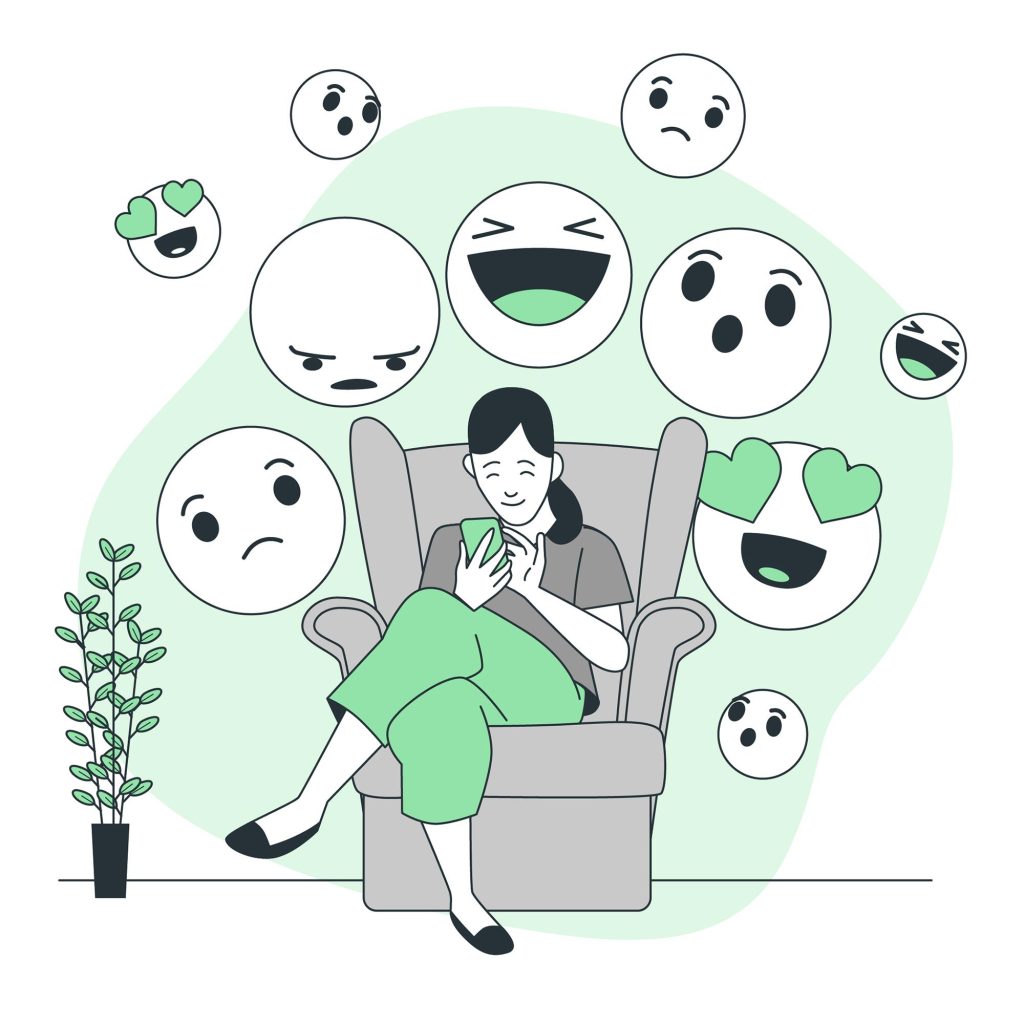
At the same time, this is a reflection of confirmation bias in psychology. Many experiments have found that humans are more willing to accept information that is consistent with their worldview, which is consistent with their prior beliefs. From another perspective, the concept of disconfirmation bias or motivated skepticism. In order to protect existing beliefs, people tend to look for reasons to refute or avoid exposure to information that negates prior beliefs, while looking for emotionally soothing truths that confirm them. (Livingston & Bennett, 2020)Although prejudice is part of human nature, many people are not aware of this tendency in themselves. This is the most harmful threat. This tendency is also often reflected in elections, when people choose to believe that the news is true if it benefits their own party. (Angelucci,Gutmann & Prat, 2024)

Social media platforms also contribute to the spread of misinformation. The recommendation algorithm is the first to be blamed. As the recommendation algorithm is driven by economic interests, the platform will thus reward content with high interaction, even if it is false. (Fernández, Bellogín & Cantador, 2021) The blogger “Maoyibei” had a large number of active fans from the very beginning. The likes, comments, and shares they made were captured by the recommendation algorithm. The “magnifying glass” effect of the socia l platform recommended this video to people who would not have paid attention to such content otherwise. The existence of social media platforms has lowered the entry threshold for the media industry. (Flew, 2021) The role of “gatekeepers” such as editors in traditional media no longer exists. A high level of clicks can generate considerable advertising revenue. The huge benefits of monetizing traffic have attracted people to engage in the self-media industry. As long as one has a camera, they can “produce” their own “news”. This kind of disinformation appear in the form of “news”, and it is hard to distinguish them from high-quality media just by looking at the titles, which causes chaos in the digital information environment. Meanwhile, the habits of liking, commenting and sharing among friends’ networks also play a huge role in promoting the spread of current popular content, and can ‘magnify the spread of fake news by orders of magnitude’. (Lazer et al., cited in Flew, 2021, p.87)

The Hidden Damages of Misinformation and Disinformation in the Post-Truth Era
Misinformation and disinformation not only bring about cognitive confusion and chaos to people, corrupt social atmosphere and public morality, but also cause a series of real harms to the entire social system. (Tran, Valecha, Rad & Rao, 2020)
The most direct consequence is the waste of social resources. In the “lost homework” incident, due to the public’s intense concern about the progress and truth of the event, various public departments got involved to investigate the truth, consuming large amounts of public resources. As the incident involved a “transnational search”, some netizens reported the incident to the police, asking for assistance in finding “Qin Lang” and his parents, which led to the public security organs in many places to launch investigation procedures. The police had to verify the clues provided by the blogger, such as the information in the exercise book, the name of the school, and further contact the education department to confirm the identity of the student. The police even screen the customs entry and exit records, which wasted a lot of manpower and material resources. Meanwhile, as the involved blogger was prosecuted for fabricating and spreading disinformation, the court initiated judicial procedures, which led to the occupation of judicial resources. Based on the information on the homework book, netizens speculated that “Qin Lang” might be a student at a certain primary school. The relevant school, due to the public attention, had to verify whether the student existed, which disrupted the normal teaching and management work.
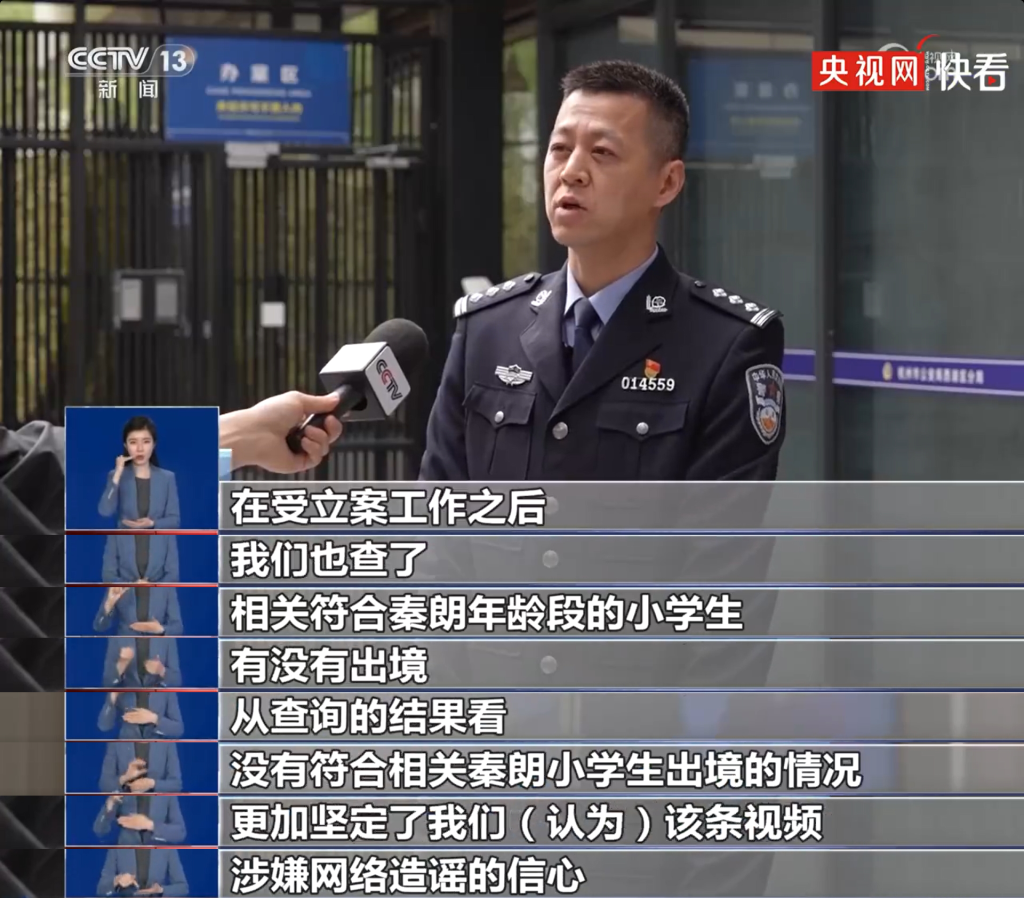
Secondly, the credibility of media and government departments has been undermined, and the public’s trust in official information has declined. Some official media institutions (e.g. local TV stations and news websites) reposted the incident without verification and allocated reporters and editors to conduct interviews. And some local government social media accounts also posted notices to search for the person, which has led the public to doubt the government departments.
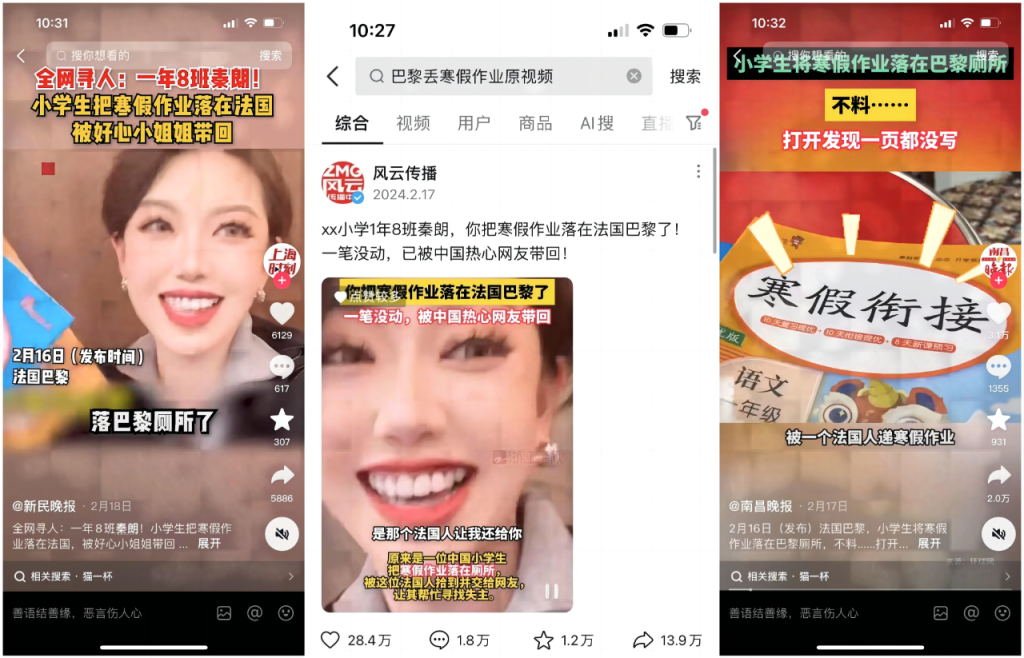
How to stay clear-headed in the post-truth era?
Therefore, what we need to do now is to take a series of efforts to deal with misinformation and disinformation.
According to the experiment on social media misinformation conducted by Harvard University, we can effectively resist and combat misinformation from three aspects: enhancing individual media literacy, platform regulation, and public policy. (Adnan, Facciani, & Weninger.2025)
On an individual level, we should start from school education, offer courses such as practical seminars to cultivate the ability to critically judge information and enhance public digital literacy. We should enable the public to master some simple fact-checking techniques, such as reverse image search, verifying the source, and being wary of “too perfect” stories. Thus, they can rationally deal with emotionally-driven information and not be swayed by emotions. In the “lost homework” incident, many netizens raised doubts and reflected after the incident, which proved the public’s educability. The platform needs to take on the responsibility of regulation, balance commercial interests with social responsibilities, and control misinformation. Taking the practices of Chinese platforms as an example, social platforms will delete content and ban the accounts involved when necessary. At the same time, the platform should also enhance the user feedback system, such as the “community notes” approach adopted by Twitter/X and Facebook for “user-led fac t-checking”. “Community notes” allow users to add explanatory notes to potentially misleading posts to provide more perspectives and information.
The platform needs to take on the responsibility of regulation, balance commercial interests with social responsibilities, and control misinformation. Taking the practices of Chinese platforms as an example, social platforms will delete content and ban the accounts involved when necessary. At the same time, the platform should also enhance the user feedback system, such as the “community notes” approach adopted by Twitter/X and Facebook for “user-led fac t-checking”. “Community notes” allow users to add explanatory notes to potentially misleading posts to provide more perspectives and information.

In terms of public policy, policymakers should consider supporting digital literacy activities and encouraging platforms to adopt feedback tools. Relevant laws and regulations should be enacted to provide a legal basis for the governance of misinformation. Different countries should adopt different governance approaches based on their national conditions. In China, according to the “Notice on Strengthening the Management of Self-media” issued by the Cyberspace Administration of China in July 2023, when self-media accounts publish content with fictional plots or dramatized elements, platforms should require them to mark such content with a prominent label indicating that it is fictional or dramatized. In 2022, the European Union passed the Digital Services Act (DSA), which also made provisions on platform governance of misinformation. DSA requires platforms to enhance the transparency of recommendation algorithms and establish effective reporting and handling mechanisms. (The Digital Services Act (DSA), n.d.)

Although the harm of disinformation is significant, some people believe that strict control over social media content may undermine freedom of speech and suppress the expression of diverse viewpoints. (Brannon, 2019) Moreover, over-reliance on platform algorithms for regulation may lead to the risk of information censorship, thereby restricting the openness and innovation of the Internet. (Ulbricht & Yeung, 2021) So, striking a balance between combating fake news and protecting freedom of speech has always been a key challenge in digital governance.
Conclusion
The “lost homework” incident demonstrated the power of emotional manipulation and the huge harm of misinformation and disinformation, while it also proved that the public can awaken. The post-truth era does not mean “truth is dead”, but rather that truth is harder to be seen. Behind fake news, there is a test of the ability to judge facts, and it also puts forward higher requirements for personal media literacy, platform regulation and public policy.
Reference List:
Times, G. (2024, April 14). Chinese vlogger banned for fabricating story of student losing homework in Paris – Global Times. Www.globaltimes.cn. https://www.globaltimes.cn/page/202404/1310580.shtml
McIntyre, Lee. Post-Truth, MIT Press, 2018. ProQuest Ebook Central, http://ebookcentral.proquest.com/lib/usyd/detail.action?docID=5294979.
Bianchi, F. P., & Tafuri, S. (2023). Spreading of misinformation on mass media and digital platforms regarding vaccines. A systematic scoping review on stakeholders, policymakers, and sentiments/behavior of Italian consumers. Human vaccines & immunotherapeutics, 19(2), 2259398. https://doi.org/10.1080/21645515.2023.2259398
Das, S. (2023). The Digital Duality: Social Media’s Impact on Society, Communication, and Language. Journal of Communication and Management.
Trending on Weibo. (2024, February 18). Chasing Clout: The Viral Saga of Qin Lang’s Lost Homework. Trending on Weibo. https://www.trendingonweibo.com/hotwords/chasing-clout-viral-saga-qin-lang-lost-homework
Jack, C. (2017, August 9). Lexicon of Lies: Terms for Problematic Information. Data & Society. https://datasociety.net/library/lexicon-of-lies/
Rachmad, Y. E. (2022). Emotional Communication Theory.
Steven Livingston and William L. Bennett. (2020). A Brief History of the Disinformation Age: Information Wars and the Decline of Institutional Authority. In Steven Livingston and William L. Bennett (Ed.), The Disinformation Age: Politics, Technology, and Disruptive Communication in the United States.
Angelucci, C., Gutmann, M., & Prat, A. (2024). Beliefs About Political News in the Run-up to an Election. https://doi.org/10.3386/w32802
Fernández, M., Bellogín, A., & Iván Cantador. (2021). Analysing the Effect of Recommendation Algorithms on the Amplification of Misinformation. ArXiv (Cornell University). https://doi.org/10.48550/arxiv.2103.14748
Flew, T. (2021). Regulating platforms . Polity Press.
Tran, T., Valecha, R., Rad, P., & Rao, H. R. (2020). Misinformation Harms: A Tale of Two Humanitarian Crises. IEEE Transactions on Professional Communication, 63(4), 386–399. https://doi.org/10.1109/tpc.2020.3029685
Adnan Hoq, Facciani, M., & Weninger, T. (2025). Feedback and education improve human detection of image manipulation on social media. https://doi.org/10.37016/mr-2020-175
Brannon, V. C. (2019). Free Speech and the Regulation of Social Media Content. In Congressional Research Service (CRS) Reports and Issue Briefs. Congressional Research Service. https://link.gale.com/apps/doc/A661274328/AONE?u=anon~e890f705&sid=googleScholar&xid=e4fce274
Ulbricht, L., & Yeung, K. (2021). Algorithmic regulation: A maturing concept for investigating regulation of and through algorithms. Regulation & Governance. https://doi.org/10.1111/rego.12437

Be the first to comment